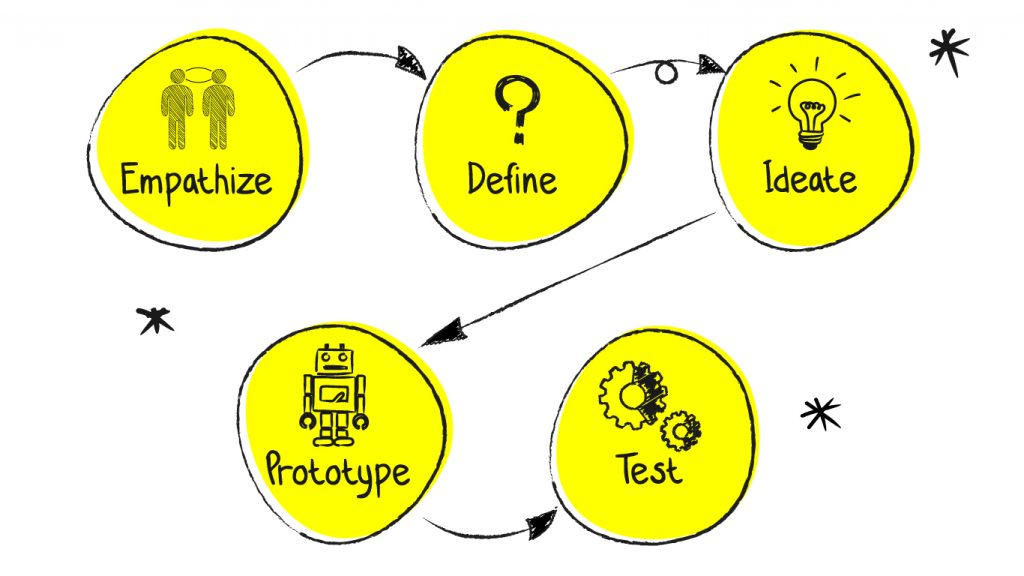Mike is a hotshot designer. He has been working at a reputed company for over ten years. But there is a marked difference between what he started out doing and what he does now.
Ten years ago, Mike would have just been called in during the final stages of product development to ensure the product looked great and aesthetically pleased the target audience. Today, he leads a team of designers who play a vital role in deciding what kind of products are built by the company.
What is the difference between then and now?
The influence of design thinking.
Although the concept was introduced in the 1950s, it gradually gained acceptance only in the 2000s. There are companies of all sizes who have applied this principle to their processes/solutions and witnessed great success. If you’re wondering if it will work for your business, or how exactly it works, then this article is for you.
Design and Design Thinking
“Every great design begins with an even better story” – Lorinda Mamo
Design and designers need no introduction. But the question that crosses people’s minds when they see the term design thinking for the first time is, “What is its connection to design?”
Put simply, design thinking refers to using the principles or concepts of design to arrive at innovative, creative, and viable solutions to complex problems. It helps break down levels of complexity into simpler, human-centric elements.
One of the core precepts of design thinking is deeply understanding the end user or the people for whom the product is designed. Empathy for the user therefore becomes the driving force behind this creative process.
Design-led firms consciously put the customer first, with 46% of design leaders citing an emotional bond with customers as a defining characteristic of an advanced design practice.
Despite being considered a deeply empathetic process, it also relies on analytics, logical thinking and other data simultaneously.
Businesses who employ design thinking in their strategy have consistently exceeded or anticipated what their customers need. Several successful companies like Google and Apple use it as an iterative process in every level of their business.
Although focusing solely on design thinking will not give you a winning edge, when used in combination with exceptional technological skills and market research, it will help you innovate and create products for the future.
Investing in design thinking is one of the best decisions a company can make if it wishes to go the extra mile and reach customers the right way.
The design thinking process
Design thinking usually works in 5 phases.
- Empathise
- Define
- Ideate
- Prototype
- Test

Empathising involves delving into the customer psyche to empathise with their wants or needs. The end result should resonate with your target audience on a personal level. This might also mean anticipating their needs beforehand and creating a solution that fills a gap even before the end customer realizes the gap exists.
The next step is to clearly outline the problem area. Once you know where to focus, coming up with a problem statement is easy. Defining the scope for the solution is key to finding the right solution.
Now the third step is where the magic happens. This is when designers brainstorm till they drop, and ideate a list of viable solutions to tackle the problem at hand. Out of the box thinking is highly encouraged and no idea is dismissed lightly. By the end of the process, there will be a select list of options that tick all the boxes.
Coming up with ideas is well and good. But to see if they are feasible, they need to be prototyped (only the best ideas of course) and tested to within an inch of their lives. Prototyping an idea that seems to have potential will help understand the nuances and technical difficulties in making it a reality.
The prototype that survives continuous tests and validates the best idea will be chosen. Even after a product is created, it will be continuously subjected to tests and customer feedback, the results of which will be used to improve and update it further.
In essence, design thinking is a continuing process of experimenting and making changes with change being the only constant. Ideate, build, test, repeat.
Why should user-centric design be a top priority?
Users today demand great design no matter the product they use. So you can either compartmentalize design and keep it one of the many creatives in your company, or make it the cornerstone your business runs on.
Research says that around 91% of unhappy customers simply leave a site without complaining. This leaves you without any feedback to rectify the error or get the customer back.
Design thinking takes a non-linear approach to dealing with non- linear problems such as these. While a logical approach to problem solving usually deals with finding the exact problem first and then addressing it, design thinking does quite the opposite.
The solution is considered in a fluid manner with only the customer at the heart of it. This empathy is what drives user-centric design. When the focus is on exploring the solution vs exploring the problem, there is a higher possibility of anticipating customer needs successfully.
A study by Forrester shows that 86% of design-led firms often or always involve design teams in shaping digital CX.

Focusing on user-centric design enables you to connect with customers on an emotional level and offer memorable experiences that will keep them coming back for more. In an age where customers are spoilt for choice, uniquely tailored customer experience could well be the key to long term customer retention.
A design-centric culture also benefits your business in other ways. It brings varied teams together as every team member feels that they are designing the product for a person or entity they are connected to. Around 40% of design-led firms foster innovations from anyone/ anywhere in the company. They also spend more on research and innovation than competitors. This approach can make your teams more agile, efficient and cross-functional.
The psychology behind design thinking
Some of the greatest thinkers and innovators of humankind across literature, music, art and engineering have employed design thinking in their works.
What sets them apart is their out of the box thinking and unique perspective. In other words, they have walked the fine line between the conscious and the unconscious, using the best of both worlds to create lasting works of art.
Creativity often lies in the grey area between the conscious and the unconscious mind. Impressions, ideas, dreams, knowledge that hasn’t been accessed in a while, are all part of the unconscious. When confronted with a problem, we automatically think along ingrained thought patterns that are habitual in nature for the unconscious mind.
Design thinking aims at thinking beyond the problem and consciously approaching it from an uncommon perspective. I.e to harness the power of both to arrive at an out of the box solution. Or in some cases, an edge of the box solution.
How does it work?
To start off, a vast number of customer stories, opinions and feedback are collected and perused by the design team. The designers put themselves in the shoes of the customers and try to empathize with their problem areas and complaints. Once they perceive the problem as their own, the quest for a solution begins.
Design teams usually approach a problem in a divergent manner and arrive at multiple solutions to tackle it. Once they have exhausted every line of thought connected to the customer pain points or needs, they filter it through the lens of practical matters like budget, time and resource constraints.
Let us take the famous example of Airbnb. When confronted with a huge loss and on the verge of going into bankruptcy, they chose to examine their problem from a user-centric perspective. They weren’t just bleeding clients, nobody was using them.
They made an intuitive decision to personally visit their clients and take professional pictures of the properties, as the pictures on the site were neither clear nor inviting.
Adding images of the properties and further details might not have seemed like a big deal, but looking at it from an end user’s perspective made all the difference.
People wanted to know what they were buying, if the place would be safe, and what kind of amenities it had. Convincing users that the properties on offer were great, and creating an excellent overall user experience was what changed the company’s fate.
Design thinking demands innovative solutions that can only be achieved by thinking along different patterns than the ones ingrained. This involves letting go of some associations, empathising, and understanding the emotional needs of the customer.
Design thinking at work
Although small companies are just starting to invest in design, several major players have already used it as part of their strategy and reaped the results. Here are some examples of how companies have implemented design thinking in their products.
1. Samsung
The Galaxy Note was introduced as the first of its kind. When research showed that people had a habit of jotting down notes on a small pocket diary when they were working, and preferred this over their phone, the quest for a solution began. The result was designing a five and a half inch phablet that featured a pen interface. The series went on to become highly successful.
2. Coca Cola
The Share A Coke campaign was a huge hit. It focused on personalizing coke bottles with the names of people, places, familial connections and social roles. In the case of people with unique or differently spelled names, the option of ordering a customized bottle was available. Apart from the names or connections, there was also something sweet and memorable about each personalization. For example, Share a Coke with Dad had the tagline “My Hero. My ATM.” under it.
This move resonated with customers on a personal level and made them look forward to their next bottle, increasing sales by 2% when it was first released in the US.

3. Pepsi
Based on market research done in China, the company decided to manufacture snacks that specifically targeted women customers. These snacks were designed in different packaging and came in a plastic tray inside a canister so that women can just open the drawer and eat from the tray. The chip is also less noisy to eat compared to its counterparts. All this stems from the fact that market research done by the giant showed that women wanted to snack differently. They didn’t want to litter the place or let people hear them crunching away.
4. Marriott
The hotel giant’s app offers millenials a customized stay at any of their properties across the globe. The app covers everything from directions to the hotel of choice after the room is booked, to service requests and room upgrades. The hotel’s VP of Digital George Corbin says that Marriott has embraced design thinking as a way to make its mobile app more of a “warm embrace” for guests.
5. Nike
Nike developed Flyknit technology during the 2012 Olympics. The shoes were made of ultra-light yarn, which was designed to improve an athlete’s performance. They were also manufactured in a highly sustainable and environmentally friendly manner that prevented waste. The brand was deliberately sending an environmentalist message at a moment of maximum global impact.
There are numerous other companies like Apple, Google, General Electric, SAP, procter & gamble, IBM, Phillips, Lego, Volkswagen, BMW and IDEO who use design thinking at multiple levels. They employ huge design teams or acquire excellent design firms to rethink their future moves strategically. Here’s an example from Samsung on how a design plan covering present and future projects would look like.

The above example clearly shows how vital the design team is for building new products. Designers are tasked with ideating products that can be signed on by the other teams. It is highly likely that not all teams will not be fully onboard with the ideas put forth by the design team.
In the case of Samsung’s phablet, the marketing team was convinced that nobody would buy a phone larger than 5 inches.
Design thinking covers all the bases during ideation. On the off chance that an idea is not feasible, the team congregates for a revised brainstorming session.
Does design thinking drive revenue?
When it comes to building products, it is clear that design thinking will give you a much needed edge.
But what’s the ROI on creativity?
Is it possible to sell it to customers? Especially if you’re in the B2B space?
Can your Sales team use design thinking as a USP?
It has been proved that it can!
Salesforce witnessed a 100% increase in revenue after its Sales team understood the value of design thinking and used it in their pitches effectively!
The process, aptly named “Sell by Design”, helped them
- Increase revenue
- Revive cold accounts
- Recreate passion for helping customers
- Increase credibility and
- Confidently seek and close bigger deals
Another great example is how Intuit increased sales by $10 million in the first year through a small, customer centric, prototype test.
A random, unplanned brainstorming session resulted in a team member questioning why the product they were selling was only sold in seats of five. Since they could find no reason for the move except that someone had once thought it a good idea, they tested out how a change could make a difference. They changed the call centre script on the fly and learnt that more people were interested in buying just one or a lesser number of seats! The result? A $10 million increase in sales!
Research by McKinsey shows that companies who have embraced design thinking showed 32% higher revenue and 56% more total return to shareholders. The interesting thing about this analysis is that it featured companies across medical technology, consumer goods and retail banking. This clearly shows that great design will help you gain higher revenue whether your company focuses on physical goods, digital products or other services.
Design thinking at Crayon’d
Many lean startups today have shown the value and impact of making decisions through prototyping and iterative learning. Although the benefits of design thinking are now being experienced across industries and platforms, there are companies who choose to outsource this process.
If you’d like to employ design thinking in your products, but aren’t sure about hiring a design team, there are companies like Crayon’d who bridge this gap effectively. Not only do they make viable product ideas a reality, they also integrate design thinking into every step of the process. Engineers, designers and marketers work together from inception to launch to build products that customers fall in love with.
The Bottom-line
Employing design thinking on an organizational level means being open to ideas, but knowing which ones would work. It also means having the space and resources to pivot and strategize even if they don’t work, keeping the failure in mind.
To sum up, does design thinking solve all your problems? No.
But does it help you innovate and create products for the future? Hell yes.







Add comment